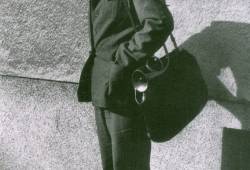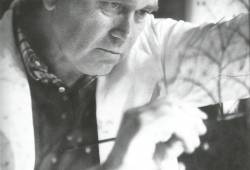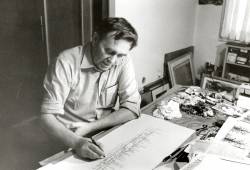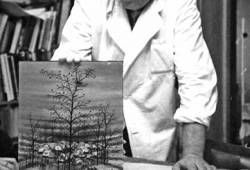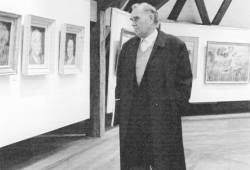Ivan Lacković Croata and the Batinske Gallery
This prominent Croatian artist, a representative of Croatian naïve painting, collector and bibliographer, was born on 1 January 1932 in the village of Batinske which is located between Kalinovac and Podravske Sesvete. His first drawings under the influence of the Hlebine School were made when he was only seven years old (1939), and with wall paint mixed with milk he painted on the walls of the village houses. He was forced to leave school and find a job in the forest industry where he unconsciously entered a world which would mark his everyday life, and later his artistic life as well.
In the mid-1950s he moved to Kloštar Podravski from where he went to Zagreb and worked as a postman. In those early years of his work, he mostly created drawings, watercolour paintings and tempera paintings. This encouraged him to attempt painting on glass and he would later paint under the influenced of motifs and styles of the Hlebine School. After he had met Krsto Hegedušić, he left his job as a postman and started painting professionally. In painting, he sought to re-establish the harmony between Man and Nature and to harmonize the rhythm of life with Mother Earth, i.e., the traditional way of living. By concentrating on form, static composition and tense immobility, he built a new world of idyllic landscapes based on numerous symbolic elements. “White roofs are images of childhood, the image of intimacy that we have deeply embedded in ourselves, hidden in the shroud, which no one’s curiosity can reveal. Everything is hidden beneath these cluttered villages whose houses look like scared flocks. What do they fear? What are they afraid of? Life’s impermanence, of course.” (Jean-Louis Depierris, 1997). In fine lines and mild color, with lightly applied brushstrokes, amplified by light, he created paintings in which the landscape became the main protagonist of his works. Henri-Frederick Amiel’s statement, “the landscape is the state of the soul” – is a statement which Lacković fully confirmed. The backbone of his art are barren images of landscape in which figurative or architectural elements make up only a small, negligible part, but an important one for the dynamism and rhythm of the composition, as a counterbalance to the distinct verticality of branched trees. Landscapes are a kind of mythical site, delocalized, without spatial and temporal determination, created on the basis of the idealized memory (and imagination) of Podravina from his lost childhood. The opus of works from the 1990s includes a series of drawings with themes of human suffering from the Homeland War. He died of a heart attack in Zagreb on 29 August 2004.
A gallery with his name was opened in Batinske in 1987 which holds a donation of about three hundred works that the painter donated to his birthplace. These works offer a complete insight into the artist’s opus: from his first works in tempera technique, through drawings from the cycle Musicians, to paintings on glass from the so-called flower phase - which became Lacković’s recognizable artistic trademark. Apart from the selection from Lacković’s donation, the permanent exhibition of the Gallery includes sculptures of Ljubica Matulec, the painter’s brother Matija Lacković, and selected works by other naïve and academic painters. The collection also features a small thematic group of sculptures by 10 authors with the theme of a postman, a kind of friendly hommage to Ivan Lacković who had worked as a postman before his painting career started. After Lacković’s death, Ivan Lacković Croata’s memorial room was set up in the Gallery. A separate ensemble is also the memorial room of the writer and Catholic public servant Petar Grgec (1890 - 1962), who was born in Kalinovac. The gallery is open on request and occasionally as part of certain cultural events. In addition, the Đurđevac Town Museum keeps a large donation of the author from 1997, which consists of more than 2,000 works of art by authors from around the world and a valuable collection of textiles, mainly from Posavina and Moslavina.



